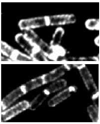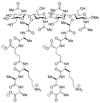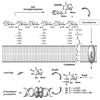Host-guest chemistry of the peptidoglycan
- PMID: 20524613
- PMCID: PMC2908483
- DOI: 10.1021/jm100086u
Host-guest chemistry of the peptidoglycan
Figures












Similar articles
-
Modifications to the peptidoglycan backbone help bacteria to establish infection.Infect Immun. 2011 Feb;79(2):562-70. doi: 10.1128/IAI.00651-10. Epub 2010 Nov 1. Infect Immun. 2011. PMID: 21041496 Free PMC article. Review.
-
The medium is the message: interspecies and interkingdom signaling by peptidoglycan and related bacterial glycans.Annu Rev Microbiol. 2014;68:137-54. doi: 10.1146/annurev-micro-091213-112844. Epub 2014 May 16. Annu Rev Microbiol. 2014. PMID: 24847956 Review.
-
Resistance to peptidoglycan-degrading enzymes.Crit Rev Microbiol. 2020 Nov;46(6):703-726. doi: 10.1080/1040841X.2020.1825333. Epub 2020 Sep 26. Crit Rev Microbiol. 2020. PMID: 32985279 Review.
-
Natural Products at Work: Structural Insights into Inhibition of the Bacterial Membrane Protein MraY.Angew Chem Int Ed Engl. 2016 Sep 19;55(39):11722-4. doi: 10.1002/anie.201606396. Epub 2016 Aug 11. Angew Chem Int Ed Engl. 2016. PMID: 27511599
-
Building peptidoglycan inside eukaryotic cells: A view from symbiotic and pathogenic bacteria.Mol Microbiol. 2020 Mar;113(3):613-626. doi: 10.1111/mmi.14452. Mol Microbiol. 2020. PMID: 32185832 Free PMC article. Review.
Cited by
-
Antibacterial Properties of Graphene-Based Nanomaterials.Nanomaterials (Basel). 2019 May 13;9(5):737. doi: 10.3390/nano9050737. Nanomaterials (Basel). 2019. PMID: 31086043 Free PMC article. Review.
-
Structure and cell wall cleavage by modular lytic transglycosylase MltC of Escherichia coli.ACS Chem Biol. 2014 Sep 19;9(9):2058-66. doi: 10.1021/cb500439c. Epub 2014 Jul 10. ACS Chem Biol. 2014. PMID: 24988330 Free PMC article.
-
Early insights into the interactions of different β-lactam antibiotics and β-lactamase inhibitors against soluble forms of Acinetobacter baumannii PBP1a and Acinetobacter sp. PBP3.Antimicrob Agents Chemother. 2012 Nov;56(11):5687-92. doi: 10.1128/AAC.01027-12. Epub 2012 Aug 20. Antimicrob Agents Chemother. 2012. PMID: 22908165 Free PMC article.
-
Identification of products of inhibition of GES-2 beta-lactamase by tazobactam by x-ray crystallography and spectrometry.J Biol Chem. 2011 Apr 22;286(16):14396-409. doi: 10.1074/jbc.M110.208744. Epub 2011 Feb 22. J Biol Chem. 2011. PMID: 21345789 Free PMC article.
-
Messenger functions of the bacterial cell wall-derived muropeptides.Biochemistry. 2012 Apr 10;51(14):2974-90. doi: 10.1021/bi300174x. Epub 2012 Mar 27. Biochemistry. 2012. PMID: 22409164 Free PMC article. Review.
References
-
- Coyette J, van der Ende A. Peptidoglycan: the bacterial Achilles heel. FEMS Microbiol. Rev. 2008;32:147–148. - PubMed
-
- Schneider T, Sahl H-G. An oldie but a goodie - cell wall biosynthesis as antibiotic target pathway. Int. J. Med. Microbiol. 2010;300:161–169. - PubMed
-
- Daniel RA, Errington J. Control of cell morphogenesis in bacteria: two distinct ways to make a rod-shaped cell. Cell. 2003;113:767–776. - PubMed
Publication types
MeSH terms
Substances
Grants and funding
LinkOut - more resources
Full Text Sources
Medical

